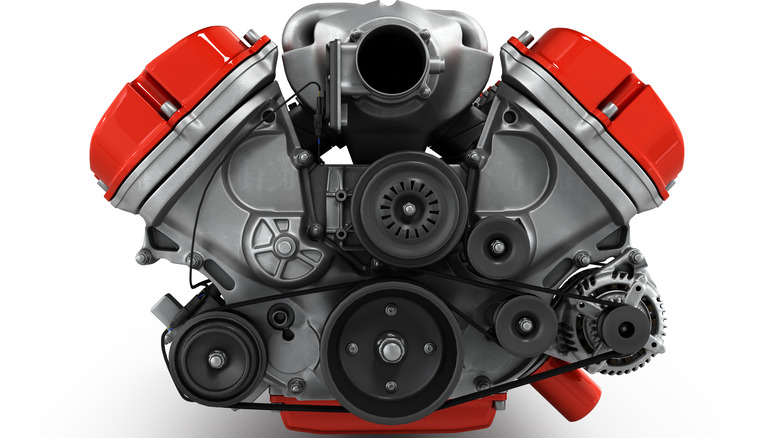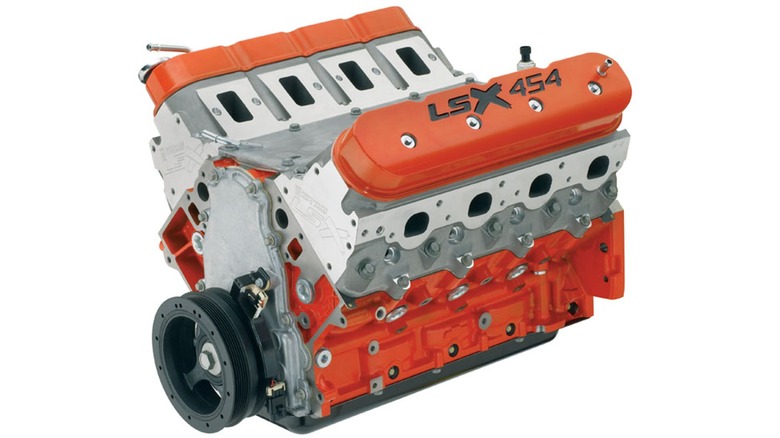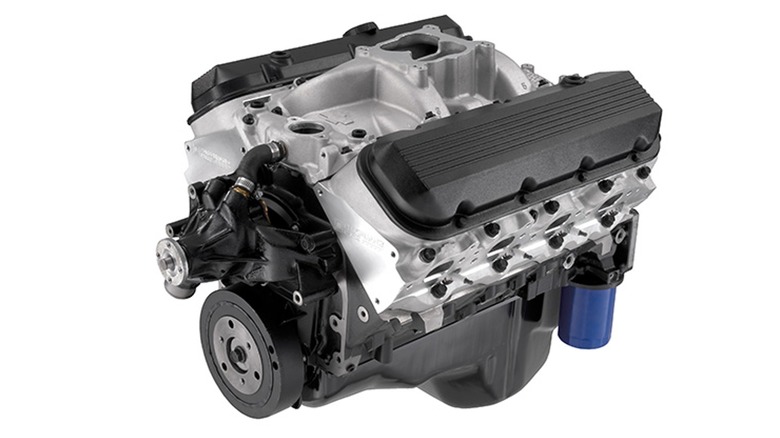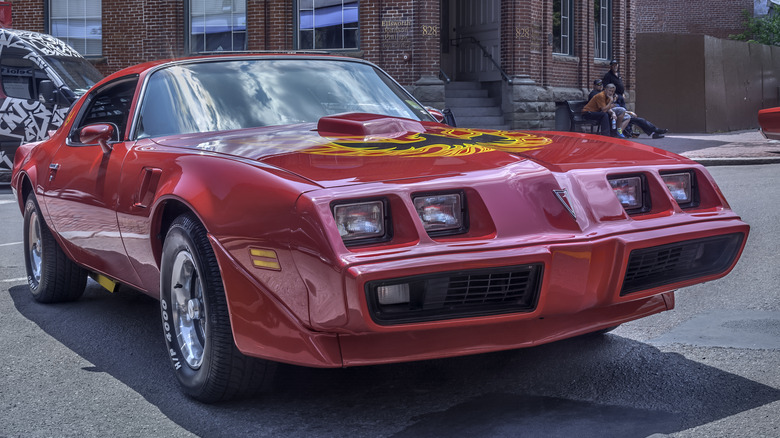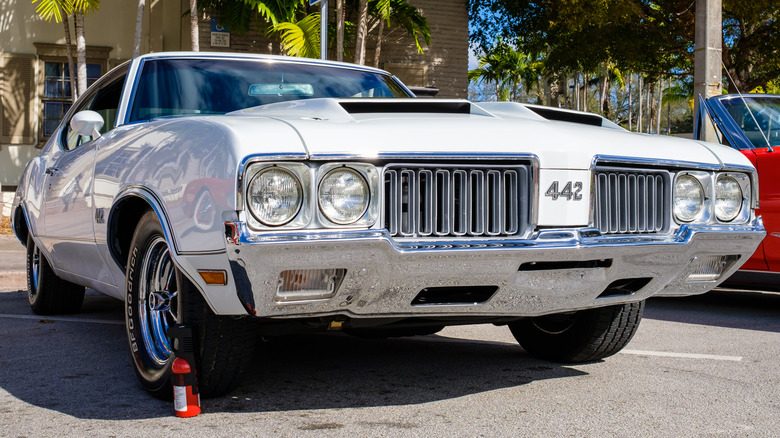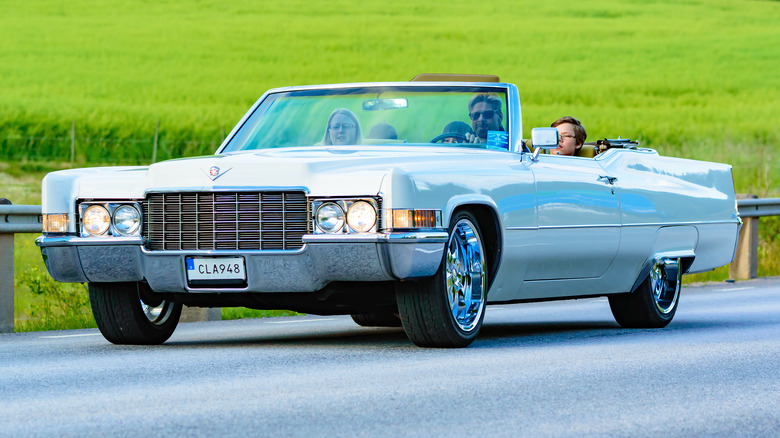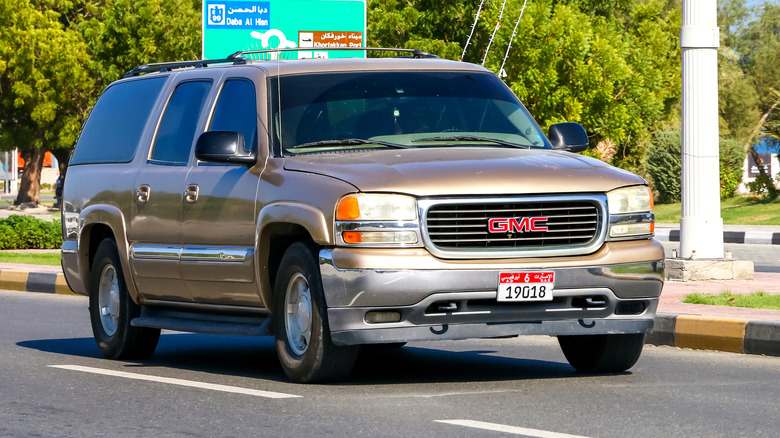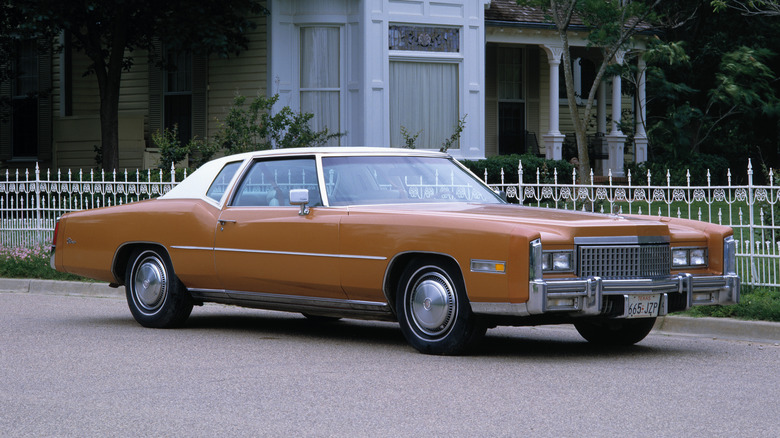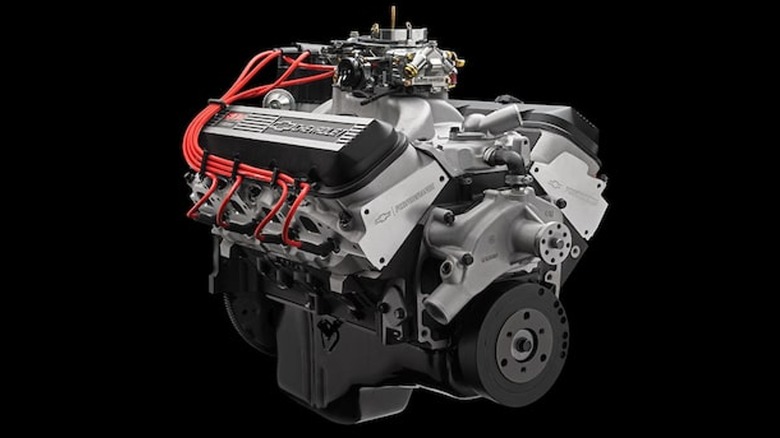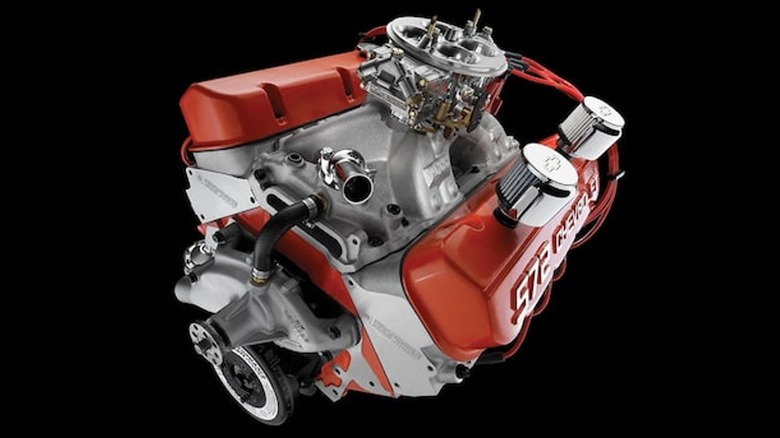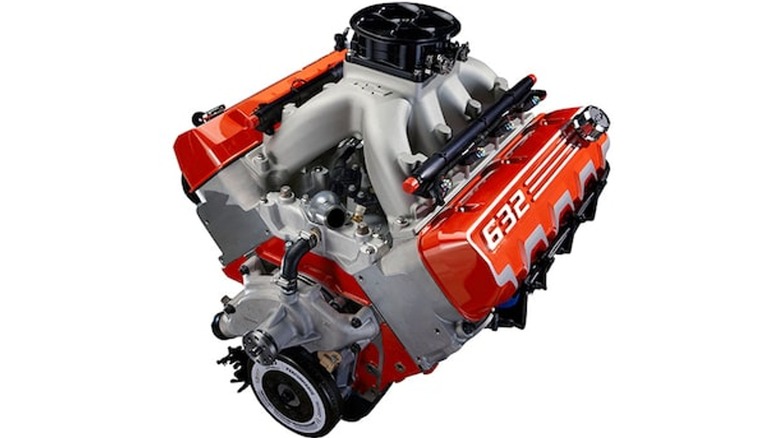10 Of The Biggest V8 Engines Ever Built By General Motors, Ranked
General Motors, a titan in the automotive industry, has been turning heads and producing iconic vehicles since its founding in 1908. Merging the strengths of Buick, Oldsmobile, Oakland, Cadillac, and Chevrolet, GM quickly established itself as a powerhouse, forever shaping the landscape of cars and trucks. One defining element of GM's evolution was the rise of the V8 engine. These powerful eight-cylinder beasts offered a thrilling combination of smooth power and throaty rumble.
Through the '50s, '60s, and early '70s, the V8 was synonymous with American muscle, powering iconic vehicles that continue to stir emotions today. With ever-increasing displacements reaching 8.2 liters, these engines boasted tire-shredding power and heart-stopping acceleration. However, the reign of these gas-guzzling giants wasn't meant to last. The oil crisis of the 1970s and stricter emission regulations forced a shift toward smaller, more fuel-efficient engines. This forced automakers to downsize or discontinue many iconic V8 engines.
Despite the era of these behemoths waning, the rumble persisted, and brands like GM continued to push boundaries and develop some of the most monstrous V8s ever conceived. Today, we delve into the world of these legendary giants, exploring the biggest V8s found under the hoods of everyday GM vehicles. These engines, ranked by displacement, range from 7.4 liters to over 10 liters. From street brawlers to drag strip dominators, prepare to discover the fascinating world of General Motors V8s, where displacement tells just part of the story.
10. 7.4-Liter LSX454 V8
Chevrolet's 454 big block is a legendary engine in muscle car history thanks to its large displacement and low-rpm power. The LSX is a modern interpretation of the 454, boasting 21st-century technology. This crate engine has an all-forged rotating assembly for superior strength, six-bolt cylinder heads for handling increased power, a hydraulic roller camshaft, hydraulic roller lifters, and orange power-coated valve covers.
While the engine is sold without most accessories and an intake manifold, it can work with a carburetor or fuel injection. With the single-plane carbureted intake manifold, the LSX454 produces an impressive 627 hp and 586 lb-ft of torque. This brings it closer to the performance of the 9.4-liter ZZ572 engine but with a lower starting price of $14,745.
Chevrolet also offered a more powerful LSX454 engine, the LSX454R, with 750+ hp and 680+ lb-ft of torque. At the time, this was the most powerful crate engine rocking a Dominator-type carburetor, a high-rise open-plenum intake manifold, and six-bolt LSX DR aluminum heads with raised ports. While the LSX454R isn't available as a crate engine, the LSX454 can match the output with just a few mods. They include an intake, a camshaft, cylinder heads, and fuel system components.
9. 7.4-Liter ZZ454 V8
General Motors' ZZ454 is a V8 crate engine boasting 7.4 liters of displacement. GM offers two ZZ454 variations: the 454 HO and ZZ454/440. The ZZ454 promises enthusiasts affordable power, with the 454 HO producing 438 hp at 5,300 rpm and 500 lb-ft of torque at 3,500 rpm. Despite its impressive performance, the 454 HO has a starting price of $8,971, with the ZZ454/440 starting at $10,095. The ZZ454 engine boasts a solid foundation with block casting, an all-forged rotating assembly, and four-bolt main caps. General Motors also fits a smooth hydraulic roller camshaft, improving the ZZ454's performance range and drivability.
In the more powerful ZZ454/440, GM opts for oval port aluminum heads, upping the performance with 30 hp and 19 lb-ft of torque. GM ships these engines with an aluminum intake manifold, balancer, water pump, and a 14-inch flex-plate. However, to get the engine running, you need additional accessories like a starter, carburetor, and ignition system from Chevrolet Performance. Surprisingly, the ZZ454 can handle some performance upgrades, including aluminum cylinder heads, hardened push rods, a crank pulley, and a supercharger, which can help bump the performance to over 700 hp.
8. 7.5-Liter Pontiac 455 V8
Pontiac introduced its 7.5-liter V8 engine in the '70s, a few years after Oldsmobile's 455 V8. While the Pontiac and Oldsmobile V8s shared the same displacement, they were different. The Pontiac 455 V8 featured a cast crank, piston, rods, and four-bolt mains. Pontiac also fitted the 455 V8 with free-flowing cast iron exhaust manifolds, enabling it to run on the soon-to-be-introduced unleaded fuel.
One of the first models to feature the Pontiac 455 V8 was the 1970 Pontiac Grand Prix. This variant used the high output (HO) 455 V8, producing 370 hp and 500 lb-ft of torque. Pontiac also fitted the 455 HO in the GTO, retaining the torque figures but lowering the performance to 360 hp. In 1973, Pontiac refined the 455, introducing a stronger version, the super duty (SD). This SD-455 engine powered vehicles like the GTO, Grand Am, and Firebird.
In the 1973 Firebird Trans Am, the engine produced 310 hp and 390 lb-ft of torque. Unfortunately, like most V8 engines of the era, the 455 V8's performance reduced over the years as more stringent emissions requirements became established, with models like the 1976 Pontiac Firebird Trans Am only producing 300 hp and 330 lb-ft of torque.
7. 7.5-Liter Oldsmobile 455 V8
While the Oldsmobile nameplate is no longer in the modern automotive market, the iconic brand gave enthusiasts vehicles like the 422, Cutlass, Tornado, Vista Cruiser, 88, and 98. It became overshadowed by other GM brands like Pontiac and Chevrolet, but it also produced one of the mightiest V8 engines of the '60s, the 455 V8. Oldsmobile's 455 V8 was a second-generation design, succeeding the original Rocket engine, which was around for 15 years.
After its debut in 1968, this was the largest engine on offer, boasting a higher deck and a longer stroke than small block V8s. At the time, Oldsmobile manufactured different variants of the 455 V8, some with altering piston designs, compression ratios, and intakes. Because of this, the output varied between 310 to 400 hp and 500 lb-ft of torque. The Oldsmobile 422 had a W30 package producing 370 hp. Despite having lower performance figures than its predecessors, this W30 package featured the 455 V8 with an aluminum intake manifold, forced air induction, and forged connecting rods.
The 1970 Tornado GT was one of the most powerful vehicles to feature the 455 V8, producing 400 hp. This engine had bigger intake valves, cast aluminum pistons, and a more aggressive hydraulic lifter camshaft. In the '70s, the performance figures of the 455 V8 decreased due to the strict emission regulations. Nowadays, the 455 V8 still lives on as an excellent option for buyers looking for a capable engine to use on their street builds.
6. 7.7-Liter Cadillac 472 V8
Since its inception in 1902, Cadillac has worked diligently to be competitive in the automotive market. Over the years, Cadillac has had plenty of technological firsts, including being the first to introduce a mass-produced V8 engine in the market in 1914. Over the years, there were multiple V8 engines, including the 331 and 390 series.
The 472 V8 was a new V8 engine boasting smooth, reliable power and advanced casting techniques. This was the successor to the 429, a V8 engine surpassed by Lincoln's 460 and Chrysler's 440 engines. Unlike the 429, the 472 V8 used fewer gasket joints and parts, making it easier to maintain. Cadillac fitted the 472 V8 in multiple vehicles, including the 1968 Cadillac DeVille. At the time, the DeVille produced 375 hp and 525 lb-ft of torque, similar performance to most modern pickup trucks and SUVs like the base GMC Sierra 1500, Toyota Tundra, Ford Expedition, and the expensive 2023 Chevrolet Tahoe RST Performance Edition.
Like most large displacement V8s of the '70s, the 472 V8 had a short lifespan, powering vehicles up to 1974. By this time, its performance had reduced, with models like the 1974 Cadillac DeVille producing 205 hp and 365 lb-ft of torque. Fortunately, the 472 V8 paved the way for its successor, the larger and more powerful 500 V8.
5. 8.1-Liter Vortec L18 V8
GM's Vortec 8100 L18 V8 was Chevy's last big block engine and one of the largest production engines ever sold in the U.S. It powered full-size SUVs, vans, and trucks as an alternative to the Duramax diesel. Like the Duramax diesel, this gasoline-powered V8 has an impressive hauling capacity. General Motors used the 454's crankcase, bumping its stroke to 4.37 inches to create the Vortec 8100 engine. The Vortec 8100 also benefited from four-bolt main bearing caps and reworked intake ports, making it different from the 454.
One of the first vehicles to use this engine was the 2001 Chevrolet Suburban, a full-size SUV offering buyers a capable and versatile vehicle that could tow and carry cargo and up to nine passengers. In the Suburban, the Vortec 8100 produced 340 hp at 4,200 rpm and 455 lb-ft of torque at 3,200 rpm. In addition to its reasonable performance, the Vortec 8100 was a durability legend, with some owners managing over 200,000 miles with proper care. This engine's narrow rev range and plentiful low-end torque made it a perfect towing alternative to the Duramax diesel, which, like most diesel powerplants, would require additional upkeep.
More vehicles used the Vortec 8100, including the Chevrolet Avalanche, Chevrolet Kodiak, Chevrolet Express, GMC Sierra 2500/3500HD, and the GMC Yukon XL. Furthermore, GM also fitted the Vortec 8100 in T-98 Kombat armored vehicles, Malibu boats, Class A motorhomes, and MasterCraft boats.
4. 8.2-Liter Cadillac 500 V8
The Cadillac 500 was one of the most noteworthy V8 engines of the brand, thanks to its 8.2-liter displacement and impressive performance. Cadillac modified the 472 V8, upping its displacement to 500 cubic inches. This revised 500 V8 had a crankshaft with 4.3 inches of stroke, similar to the 472 V8. However, unlike its predecessor, the 500 V8 produced 400 hp and 550 lb-ft of torque in the Eldorado. At the time, the Eldorado was Cadillac's flagship vehicle, boasting leather surfaces, polished wood, and a comfortable ride. This made the 500 V8 the perfect powertrain, enabling the Eldorado to drive gracefully and rival the performance and quality of European luxury cars from Mercedes-Benz and Bentley.
Unfortunately, the 500 V8's time was limited, and it was only in production from 1970 to 1976 due to the strict emissions regulations. This led to the introduction of a lower compression ratio for unleaded gasoline and equipment like catalytic converters. In its final form, the 500 V8 only managed to produce 190 hp and 360 lb-ft of torque. Despite no longer being in production after 1976, the engine gained a cult following with some gearheads fitting it into various vehicles, including this Buick Regal with 806 hp and 747 lb-ft of torque.
Cadillac didn't produce another engine like the 500 V8 until the introduction of the Blackwing V8 in 2019, which powered its flagship sedan, the AWD beast Cadillac CT6-V. This twin-turbocharged 4.2-liter V8 produced an impressive 550 hp and 640 lb-ft of torque. This engine was paired with a 10-speed automatic transmission, sending power to all four wheels. The result was a blistering 0 to 60 mph sprint of 3.8 seconds.
3. 8.2-Liter ZZ502 V8
The ZZ502 is another big block V8 crate engine, boasting affordable performance like the ZZ454. However, unlike the ZZ454, the ZZ502 is available in more flavors, and they all produce more power. The ZZ502 lineup includes the HT502, 502 HO, ZZ502/502 Deluxe, and ZZ502/502 Base. While the entire lineup has an 8.2-liter displacement, the HT502 has the lowest performance figures of 406 hp at 4,200 rpm and 541 lb-ft of torque at 3,200 rpm. This makes it a great truck engine, thanks to its impressive trailer-tugging torque, which surpasses the engines in the base Toyota Tundra and Ford F-150.
Despite being the least powerful engine in the ZZ502 lineup, it is more potent than the ZZ454 and boasts a lower starting price of $8,295. Like most of its big block siblings, the ZZ502 engine has great durability and strength thanks to its all-forged rotating assembly. It also uses GM's latest-generation block casting with four-bolt main caps and a hydraulic roller camshaft. This enables the ZZ502 engine lineup to produce more power and torque.
One of the notable variants is the 502 HO, which has a slightly higher starting price of $10,166. It also has more performance, producing 461 hp at 5,100 rpm and 558 lb-ft of torque at 3,400 rpm, making it ideal for the strip, street, and towing. Both ZZ502/502 engines produce the most performance, boasting 508 hp and 580 lb-ft of torque. The additional power increase also contributes to its higher $12,785 price tag.
2. 9.4-Liter ZZ572 V8
The ZZ572 is a 9.4-liter V8 engine available in two configurations: the 620 Deluxe and 720R Deluxe. These are among the most powerful V8s from GM, but they're only available as crate engines, ideal for use in custom builds like Ernie Miyamoto's 1972 Volkswagen Super Beetle. The 620 Deluxe produces 621 hp and 645 lb-ft of torque, making it suitable for the street and drag strip. It boasts a forged crankshaft, aluminum rectangular port heads, and raised exhaust ports. Fortunately, this ZZ572 engine also has a fully assembled bottom, allowing you to fit an induction system of your choice. In addition to its impressive performance, the ZZ572/620 Deluxe engine commands a price premium of $19,664.
GM also offers a more powerful 720R Deluxe engine, boasting 727 hp and 680 lb-ft of torque. This is an excellent alternative for enthusiasts looking to build a sub-10-second car. Like the 620 Deluxe, the ZZ572/720R Deluxe has a higher starting price of $20,359. While GM offers the ZZ572 with a Dominator-style 1,150-cfm carburetor, buyers should add accessories like a starter, transmission controller, and fuel pump to get it running.
1. 10.4-Liter ZZ632 V8
The ZZ632 is General Motors' largest and most powerful V8 engine. Chevrolet introduced the ZZ632 in 2021, offering enthusiasts a naturally aspirated 10.4-liter V8 engine with 1,004 hp and 876 lb-ft of torque. The ZZ632 sits at the top of Chevrolet's crate engine lineup, boasting a steep starting price of $32,935. This V8 engine delivers peak power at 6,600 rpm and has a peak of 7,000 rpm. To sustain the output, the ZZ632 has CNC-machined high-flow aluminum cylinder heads with symmetrical ports. Chevrolet maintains the symmetry in the intake and exhaust ports, ensuring every cylinder performs similarly.
In addition, the ZZ632 shares its iron block mold with the ZZ572, but Chevrolet machines the castings to accommodate the large 10.4 liters of displacement. Like most GM crate engines, the ZZ632 has a forged rotating assembly and four-bolt main caps for enhanced durability and strength. All these aspects help make the ZZ632 a capable performance engine. Since its introduction, the ZZ632 has been in multiple creations, including Hoonigan's third-generation Chevrolet Camaro build.
